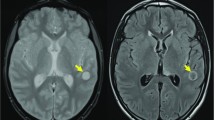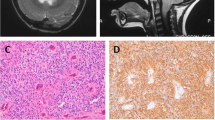Abstract
Myxopapillary ependymoma is a rare variant of ependymoma, almost exclusively occurring in the region of the cauda equina and filum terminale. We describe a myxopapillary ependymoma located in the left cerebellopontine angle of a young man suffering from peripheral vertigo and left sensorineural hearing loss for years. The patient underwent surgical removal of the tumour. Microscopic examination showed histological and immunohistochemical features consistent with a diagnosis of myxopapillary ependymoma. Imaging studies of the spine yielded normal findings, confirming the lesion’s primary nature. To the best of our knowledge, this is the first case of primary intracranial myxopapillary ependymoma described in this location.



Similar content being viewed by others
References
Anderson MS (1966) Myxopapillary ependymomas presenting in the soft tissue over the sacrococcygeal region. Cancer 19:585–590
Brackmann DE, Kwartler JA (1990) A review of acoustic tumours: 1983–1988. Am J Otol 11:216–232
Chamberlain MC (2003) Ependymomas. Curr Neurol Neurosci Rep 3:193–199
Fink KL, Rushing EJ, Schold SC Jr, Nisen PD (1996) Infrequency of p53 gene mutations in ependymomas. J Neurooncol 27:111–115
Hamilton RL, Pollack IF (1997) The molecular biology of ependymomas. Brain Pathol 7:807–822
Kernohan JW (1932) Primary tumors of the spinal cord and intradural filum terminale. In: Penfield W (ed) Cytology and cellular pathology of the nervous system, vol 3. Hoeber, New York, pp 993–1025
Kernohan JW, Woltman HW, Adson AW (1948) Glioma of the cerebellopontine angle. J Neuropathol Exp Neurol 7:349–367
Kleihues P, Cavenee WK (2000) World Health Organization classification of tumors of the nervous system. Ependymal tumors. In: Pathology and genetics of tumours of the nervous system, World Health Organization classification of tumours. IARC Press, Lyon, pp 71–83
Lim SC, Jang SJ (2006) Myxopaplillary ependymoma of the fourth ventricle. Clin Neurol Neurosur 108:211–214
Mallucci CL, Ward V, Carney AS, O’Donoghue GM, Robertson I (1999) Clinical features and outcomes in patients with non-acoustic cerebellopontine angle tumours. J Neurol Neurosurg Psychiatry 66:768–771
Maruyama R, Koga K, Nakahara T, Kishida K, Nabeshima K (1992) Cerebral myxopapillary ependymoma. Hum Pathol 23:960–962
Matyja E, Naganska E, Zabek M, Koziara H (2003) Myxopapillary ependymoma of the lateral ventricle with local recurrences: histopathological and ultrastructural analysis of a case. Folia Neuropathol 41:51–57
Mork SJ, Loken AC (1977) Ependymoma: a follow-up study of 101 cases. Cancer 40:907–915
Plans G, Brell M, Cabiol J, Villa S, Torres A, Acebes JJ (2006) Intracranial retrograde dissemination in filum terminale myxopapillary ependymomas. Acta Neurochir 148:343–346
Prayson RA (1997) Myxopapillary ependymomas: a clinicopathologic study of 14 cases including MIB-1 and p53 immunoreactivity. Mod Pathol 10:304–310
Ralte AM, Rao S, Sharma MC, Suri A, Gaikwad S, Sarkar C (2004) Myxopapillary ependymoma of the temporal lobe—report of a case of temporal lobe epilepsy. Clin Neuropathol 23:53–58
Russell DS, Rubinstein LJ (1989) Myxopapillary ependymoma. In: Bigner DD, McLendon RE, Brunek JM (5th ed): Pathology of Tumours of The Nervous System, London, pp 203–206
Sato H, Ohmura K, Mizushima M, Ito J, Kuyama H (1983) Myxopapillary ependymoma of the lateral ventricle. A study of the mechanism of its stromal myxoid change. Acta Pathol Jpn 33:1017–1025
Sonneland PRL, Scheithauer BW, Onofrio BM (1985) Myxopapillary ependymoma. A clinicopathologic and immunocytochemical study of 77 cases. Cancer 56:883–893
Svien H, Mabon RF, Kernohan JW, Craig WM (1953) Ependymoma of the brain: pathologic aspects. Neurology 3:1–15
Tseng YC, Hsu HL, Jung SM, Chen CJ (2004) Primary intracranial myxopapillary ependymomas: report of two cases and review of the literature. Acta Radiol 45:344–347
Tong CY, Ng HK, Pang JC, Hui AB, Ko HC, Lee JC (1999) Molecular genetic analysis of non-astrocytic gliomas. Histopathology 34:331–341
Ueyama T, Tamaki N, Kondoh T, Kokunai T, Asada M (1997) Cerebellopontine angle ependymoma with internal auditory canal enlargement and pineal extension—case report. Neurol Med Chir (Tokyo) 37:762–765
Warnick RE, Raisanen J, Adornato BT, Prados MD, Davis RL, Larson DA, Gutin PH (1993) Intracranial myxopapillary ependymoma: case report. J Neurooncol 15:251–256
Wu J, Ye Z, Darras BT (1993) Frequency of p53 tumor suppressor gene mutations in human primary brain tumors. Neurosurgery 33:824–831
Author information
Authors and Affiliations
Corresponding author
Additional information
Comments
Luciano Mastronardi, Rome, Italy
This is a very rare case of myxopapillary ependymoma of the posterior cranial fossa, the first reported in the cerebellopontine angle. On the basis of the MRI/TC data, the first clinical-neuroradiological diagnosis was of acoustic schwannoma. The surgeons preferred to include in their approach also the transpetrosal route (retrolabirinthyne). It is surprising that in the description of the case the authors affirmed that the patient had a preoperative severe hearing loss and a postoperative facial palsy, whereas at the followup control the neurological examination seemed to be normal. The only interpretation of this finding is that with skilful dissection the surgeon detached the tumor from the acoustic nerve decompressing it. Even if this case can be considered an exceptional finding, it is important to take into account that not always a CPA tumor is a schwannoma. The auspicion is that the technological improvement of MRI (spettroscopy, etc) will be helpuful in the near future for differential diagnosis of these tumors.
Rights and permissions
About this article
Cite this article
Sparaco, M., Morelli, L., Piscioli, I. et al. Primary myxopapillary ependymoma of the cerebellopontine angle: report of a case. Neurosurg Rev 32, 241–244 (2009). https://doi.org/10.1007/s10143-008-0160-6
Received:
Revised:
Accepted:
Published:
Issue Date:
DOI: https://doi.org/10.1007/s10143-008-0160-6




